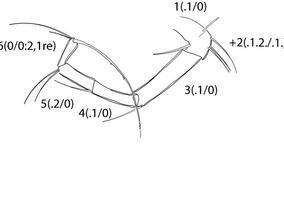You are here
Taxon Pages
Cytherella rwhatleyi Brandão, 2008
Nomenclature
-
Family: CytherellidaeGenus: Cytherella
SUMMARY
In lateral view, RV and LV oval – sub-rectangular; very wide rim present on entire valve margin in males, but only on anterodorsal to ventral areas of valves in females; anterior margin more broadly rounded than posterior; pronounced selvage present, with shorter and longer radial setae. Lateral surface with medium-sized, shallow, punctae present on almost entire valve surface except by the adductor muscle scar and ventral – anteroventral areas. Genital lobe proximally subcircular, with “beak-shaped” distal process, which is convex anteriorly and concave posteriorly. HP very elongated and relatively thin, with “heart-shaped” proximal lobe, and subtriangular distal lobe. ber). Females brooded from 0 to 6 eggs, with a maximum of 3 eggs per valve (Fig. 6, Tab. 2), in average 3.6 eggs / female; exact position of single eggs in brood chamber also varied (ventral, medial or dorsal).
Antennula robust, with 7 podomeres, podomere 3 subtriangular; Base of antenna with barbed dorsal margin; endopodite podomere 1 with 6 (3 ventral plus 3 distal) modified setae, which lack any kind of pore indicative of chemical reception. Coxa of mandibula with 2 endites finely denticulate distally; approximatelly 60 comb setae. Endites of maxillula with numerous setae and barbae. Fifth limb strongly sexually dimorphic, endopodite well developed, hook-shaped in male and reduced in female. Sixth limb also strongly sexually dimorphic, endopodite well developed, hook-shaped in male and absent in female. Furcae a pair of lamella bearing 9 to 11 feathered setae plus 1 reduced seta. Male copulatory limb very elongated and relatively thin, with “heart-shaped” proximal lobe, and subtriangular distal lobe. Genital lobe proximally subcircular, with “beak-shaped” distal process, which is convex anteriorly and concave posteriorly. Trunk with 11 segments, males bearing several short setae and females bearing long setae. Male copulatory limb inserted in segments 5 to 7 (segment I most posterior, following Tsukagoshi et al. 2006), genital lobe inserted in segments 5 to 8.






